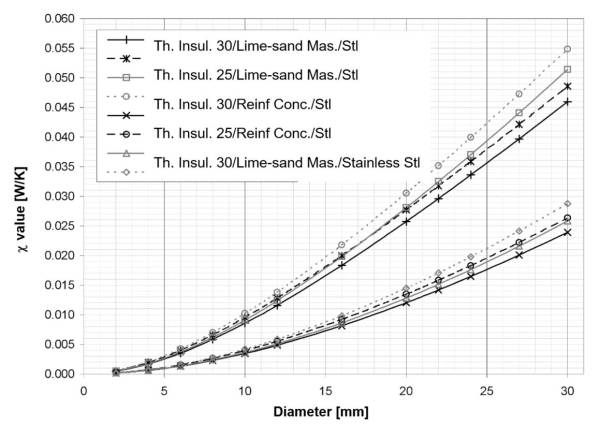Appendix A - Punctiform penetrations of thermally insulated exterior walls
Passivhaus Institut, Darmstadt
For estimating how high the additional heat loss due to fastening elements that penetrate the thermally insulated outer shell is, $\chi $-values for steel and high-grade steel anchors are provided in the following section. Two insulation thicknesses and two anchoring substrates are considered. The results are summarised Fig. A1. Here one can see the significant reduction in the $\chi $-value when high-grade steel is used instead of structural steel.
In the case of structural steel which is more thermally conductive, the thermal conductivity of the anchoring substrate has a greater effect than the insulation thickness of the exterior wall. This applies in particular to the larger rod diameters. On the other hand, with stainless steel the thermal conductivity of the anchoring substrate has less influence than the insulation thickness. If thin anchor cross-sections (up to approx. 10 mm) are used, the influence of the insulation thickness and the anchoring substrate can be disregarded for both steel and high-grade steel elements. This is illustrated by the following example: a façade is attached using four steel anchors per m², each with a diameter of 6 mm. Table A1 shows the corresponding $\chi $-values and the impact on the U-value of the wall:
| Exterior wall | Insulation thickness | U-value of the uninterrupted wall | $\chi $-value of each anchor | U + ΔU | Increase in the U-value |
| Masonry wall | 30 cm | 0.127 W/(m²K) | 0.0035 W/K | 0.141 W/(m²K) | 11.1 % |
| Masonry wall | 25 cm | 0.151 W/(m²K) | 0.0040 W/K | 0.167 W/(m²K) | 10.6 % |
| Reinforced concrete | 30 cm | 0.129 W/(m²K) | 0.0037 W/K | 0.143 W/(m²K) | 11.5 % |
| Reinforced concrete | 25 cm | 0.153 W/(m²K) | 0.0042 W/K | 0.170 W/(m²K) | 11.0 % |
| Table A1: Worsening of the U-value of the uninterrupted exterior wall due to ventilated rainscreen cladding with four steel anchors per m² each with a diameter of 6 mm |
The results are presented in detail in the following illustrations. The boundary conditions of the calculations can be seen in Table A2:
| Components | Thermal conductivity [W/(mK)] |
| Plaster | 0.7 |
| Thermal insulation | 0.04 |
| Sand-lime bricks | 1.0 |
| Reinforced concrete | 2.3 |
| Structural steel | 50 |
| High-grade steel | 17 |
| Table A2: Characteristic values of materials |
In addition to steel anchors and rods, brackets are also often used to attach façades or balconies. The extent to which the -values of round cross-sections can be transferred to angular cross-sections is analysed in another calculation (Fig. A6).
In doing so, it is assumed that the cross-section of the steel rod and steel bracket penetrating the insulation remains the same (Fig. A7).
A relatively good correlation was seen for penetrating cross-sections. The longer and thinner the cross-section is, the greater the deviation from the $\chi $-value of the round cross-section. As a rough estimate, the $\chi $-value of the equivalent round cross-section can be increased by 50 % for unfavourable angular cross-sections.







